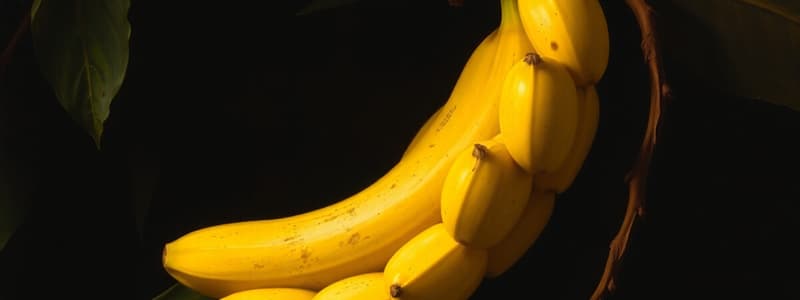Podcast
Questions and Answers
What is the scientific name of the banana?
What is the scientific name of the banana?
- Citrus sinensis
- Mangifera indica
- Musa paradisiaca
- Musa acuminata (correct)
From which region are bananas thought to have originated?
From which region are bananas thought to have originated?
- Africa
- South America
- Malaysia (correct)
- The Caribbean
What is the name given to bananas used for cooking in some countries?
What is the name given to bananas used for cooking in some countries?
- Cavendish
- Burros
- Plantains (correct)
- Manzanos
What two wild species do almost all modern edible seedless bananas come from?
What two wild species do almost all modern edible seedless bananas come from?
What is the term for the ability to create a new crop without the need for fertilization, as seen in the domestication of bananas?
What is the term for the ability to create a new crop without the need for fertilization, as seen in the domestication of bananas?
Which diet is bananas a component of?
Which diet is bananas a component of?
Which type of banana sucker is considered the best for planting?
Which type of banana sucker is considered the best for planting?
What is the average period of productive banana growth without replanting?
What is the average period of productive banana growth without replanting?
What is a key practice to discourage possible infection of banana plants after pruning suckers?
What is a key practice to discourage possible infection of banana plants after pruning suckers?
Which banana cultivar is at risk of disappearing from commercial production due to Tropical Race 4 (TR4)?
Which banana cultivar is at risk of disappearing from commercial production due to Tropical Race 4 (TR4)?
Flashcards
Banana
Banana
Edible fruit from large herbaceous flowering plants (Musa genus). Variable in size, color and firmness.
Parthenocarpy
Parthenocarpy
Ability to produce fruit without fertilization, leading to seedless bananas.
Plantain
Plantain
A type of banana, typically greener and larger, prepared fried, mashed, or boiled.
Vegetative Propagation
Vegetative Propagation
Signup and view all the flashcards
Water Sucker
Water Sucker
Signup and view all the flashcards
Sword Suckers
Sword Suckers
Signup and view all the flashcards
Pruning
Pruning
Signup and view all the flashcards
Black Sigatoka
Black Sigatoka
Signup and view all the flashcards
Banana Bunchy Top Virus (BBTV)
Banana Bunchy Top Virus (BBTV)
Signup and view all the flashcards
Banana Bacterial Wilt (BBW)
Banana Bacterial Wilt (BBW)
Signup and view all the flashcards
Study Notes
Banana Basics
- Bananas, botanically known as Musa acuminata, belong to the Musaceae family.
- A banana is an edible fruit from large herbaceous flowering plants in the genus Musa.
- In some regions, cooking bananas are known as plantains.
- Banana fruit exhibits variations in size, color, and firmness.
- Bananas are usually elongated and curved with a soft, starchy flesh
- The rind, which covers the fruit, can be green, yellow, red, purple, or brown depending on ripeness.
- Fruits grow in clusters from the top of the plant.
- Modern edible seedless bananas derive from two wild species: Musa acuminata and Musa balbisiana.
- Bananas are believed to have originated in Malaysia approximately 4,000 years ago.
- Alexander the Great's army documented bananas circa 327 BC.
- Banana clusters contain 50-150 fruits, divided into 10-25 bunches called "hands".
- Roughly 50 species exist within the Musa genus, encompassing both bananas and plantains.
Cultivation and Consumption
- Bananas (Musa spp.) thrive as a tropical crop in wet regions such as Africa, the Americas, South and Southeast Asia, and the Pacific Islands.
- About 87% of bananas are consumed locally, with the remainder distributed beyond tropical areas.
- Bananas have undergone cultivation and hybridization for thousands of years.
- Edible bananas are hybrids of Musa acuminata (diploid) or M. acuminata crossed with M. balbisiana (triploid).
- M. acuminata is found throughout Southeast Asia.
- M. balbisiana is mainly in mainland Southeast Asia.
- Domestication of M. acuminata led to seed suppression and parthenocarpy, enabling cultivation without fertilization.
Economic and Nutritional Aspects
- Bananas are a popular fruit in America.
- Bananas can be eaten raw or used in chips, ice cream sundaes, oatmeal, pancakes, and cereal.
- The BRAT diet (Bananas, Rice, Applesauce, Toast) includes bananas for those with diarrhea or upset stomachs.
- Bananas contain potassium, which regulates fluid balance, and fiber, which aids digestion.
- Plantains, a larger, green banana variant, are commonly fried, mashed, or boiled, especially in Latin American cuisine.
Banana Varieties
- Gros Michel bananas are flavorful but vulnerable to Panama disease and leaf spot.
- Cavendish bananas are a hardier group.
- Cavendish bananas have been crossed with Gros Michel to produce commercial varieties.
- Other varieties include Cavendish, Valery, Lacatan, and Robusta.
- Valery, Lacatan, and Robusta are the top three cultivated varieties.
Planting Methods
- Bananas are propagated vegetatively.
- Pseudo stems produce maiden, water, and sword suckers.
- Water suckers have the same width from top to bottom.
- Water suckers originate from a remote or grandparent corm.
- Do not use water suckers for planting.
- Sword suckers are vigorous, produced by the main stem, large at the bottom, and taper upwards.
- Sword suckers have long, thin leaves.
- Sword suckers are the best for planting.
- Maiden suckers are between sword and water suckers with tapering stems and narrower leaves.
- Maiden suckers are good planting materials.
- The best plants come from old stems' corms with one or two buds.
Growing and Planting
- Bananas grow for several years in alluvial valleys and plains.
- Banana plants can remain productive for 10–20 years without replanting.
- The average productive growth period without replanting is approximately 5 years.
- This 5 year period is common for crops planted on clayey soils.
- New banana planting materials must be free of pests and diseases.
- Inspect old corms or suckers for plant borers and nematodes.
- Remove all roots and trash, and cut away any decaying stem portions.
- Dip the stem in Nemagon with a sticker like Triton.
- Plant suckers or corms ("heads") in holes about 45cm wide and 45cm deep.
- Space plants about 2.4m x 2.1m apart.
- Spacing depends on soil fertility, land slope, and variety.
- Bananas are now sold by weight instead of by stem or bunch.
- Farmers aim to produce a high yield per hectare.
- Reducing the spacing between plants allows more plants per hectare, increasing yield.
Fertilization and Pruning
- Bananas need fertilizer to maintain high production levels.
- Apply fertilizer at least twice per year.
- Adjust fertilizer type and rate according to soil testing.
- A mixed fertilizer is generally recommended.
- Bananas do not usually show major mineral deficiencies.
- The approach to pruning suckers has changed due to selling bananas by weight.
- In fertile soils, keep up to four or five suckers per parent plant.
- In less fertile soils, allow only two suckers at different developmental stages.
- Decide if and how much sucker removal is needed.
- Remove unwanted suckers from the parent plant using a sharp tool like a cutlass.
- Cut between the sucker and the parent plant.
- Remove suckers furthest from the parent or on a lower slope.
- They are less firmly established.
- Make a smooth, clean cut to prevent infection.
Harvesting and Post-Harvest
- Cut off the top of the pseudo stem and leave it as mulch at the base of the plant.
- Pseudo stems can also be fed to cattle or used as supplementary feed.
- Most losses occur during harvesting.
- Bunches are often rejected if fruits are immature or bruised.
- Wrap young fruits in polythene bags to prevent grazing.
- Transport bananas from the field to boxing plants.
- Cut bananas into hands, wash, and box for shipping.
- Dip banana hands in growth regulators like gibberellins to improve post-harvest storage.
- Keep bananas at 13°C to 15°C with 85% relative humidity to extend storage time.
Pests and Diseases
- Banana bunches are sometimes encased in plastic bags.
- These bags can be coated with pesticides.
- The Cavendish banana cultivar is at risk of becoming unviable in the next 10–20 years due to lack of genetic diversity.
- 'Gros Michel' followed this fate.
- Lack of genetic diversity in bananas makes them vulnerable to diseases.
Panama Disease
- Panama disease comes from a Fusarium soil fungus (Race 1).
- Panama disease enters through the roots.
- The fungus spreads through water to the trunk and leaves.
- Gels and gums are produced that cut off water and nutrient flow, wilting the plant and exposing it to sunlight.
- Before 1960, "Gros Michel" was the main banana, but highly susceptible to Panama disease.
- Cavendish replaced Gros Michel because, among resistant varieties, it has the best quality fruit.
- Cavendish requires more shipping care, and its quality is debatable compared to Gros Michel.
Tropical Race 4
- Tropical Race 4 (TR4) is a Panama disease strain discovered in 1993.
- TR4 has eliminated Cavendish bananas in several Southeast Asian countries.
- This has not yet reached the Americas.
- Soil fungi spreads via footwear, clothing, or tools.
- TR4 is likely to enter Latin America this way.
- Cavendish is susceptible to TR4.
- Cavendish is likely to disappear from commercial production due to TR4.
- The only known defense to TR4 is genetic resistance.
Black Sigatoka
- Black Sigatoka is a fungal leaf spot disease first observed in Fiji in 1963 or 1964.
- Also known as black leaf streak.
- The disease spread through tropics via infected banana leaves used as packing.
- Black Sigatoka affects all banana and plantain cultivars.
- Photosynthesis is impeded by blackening of leaves.
- Leaves eventually die.
- Fruit production decreases by 50% or more.
- Bananas ripen prematurely, making them unsuitable for export.
- The fungus is becoming resistant to treatment.
- Treatment is costly.
- Intense spraying is raises environmental concerns.
- Some resistant bananas have been developed, but lack commercial acceptance due to taste and texture.
Banana Bunchy Top Virus
- Banana Bunchy Top Virus (BBTV) spreads via aphids.
- BBTV stunts leaves, causing a "bunched" appearance.
- Infected plants usually do not produce fruit.
- Mild strains exist but are mistaken for malnourishment.
- There is no cure for BBTV.
- Effects can be minimized by planting tissue-cultured plants, controlling aphids, and destroying infected plants.
Banana Bacterial Wilt
- Banana Bacterial Wilt (BBW) is caused by Xanthomonas campestris pv. musacearum.
- BBW was originally found on Ensete ventricosum in Ethiopia in the 1960s.
- BBW appeared in Uganda in 2001.
- BBW affects all banana cultivars.
- BBW has been diagnosed in Central and East Africa, including Rwanda, the Democratic Republic of the Congo, Tanzania, Kenya, Burundi, and Uganda.
Studying That Suits You
Use AI to generate personalized quizzes and flashcards to suit your learning preferences.




